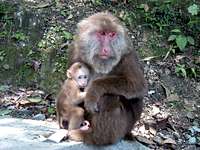|
|
Mountain/Rock |
|---|---|
|
|
32.91649°N / 93.51563°E |
|
|
Hiking |
|
|
Spring, Summer, Fall |
|
|
10167 ft / 3099 m |
|
|
Overview
Emei Shan is one of the four holy Buddhist Mountains of China. At one time, the mountain sheltered well over one hundred Buddhist monasteries. Today, more than 20 are still active after the majority was destroyed by the nihilistic Cultural Revolution. Today the mountain is a major tourist attraction in southwest China in the province of Sichuan. Domestic and foreign tourists flock to Emei Shan to see the remaining holy monasteries and also the many monkeys who still call the mountain home. This mountain is also famous for saint lamps, or Buddha’s Aureole, which are often seen from the summit. The halos were believed to be a consequence of holy enlightenment. The newly enlightened individual would often plunge to his death by jumping off the Cliff of Self-Sacrifice!There are two main trails that can be hiked. If you aren’t in the mood to walk up the endless staircases, you may choose to ride in a sedan chair or take a series of cable cars. Both of the main trails are very well maintained. Do not expect solitude or anything like it. Emei Shan will deliver a truly Chinese mountain experience…crowds, porters, merchants, bamboo forests, Buddhist temples at every turn.
The most famous monasteries are Baoguo Si (Patriotic Declaration Temple), Wannian Si (万年寺, Ten thousand Years Temple), Xixiang Chi (洗象池,Elephant Bathing Pool), Jinding Si (金顶寺, Golden Summit Temple), Wanfo Si (万佛寺, Ten Thousand Buddha Temple). Many of the temples have been rebuilt or renovated recently and some work will likely be ongoing if you visit. Wannian Si represents the oldest existing architecture in the area; it still survives from the 9th century.
Wanfo Si is the highest point of Emei Shan (3099m), although most visitors stop at Jinding Si (3077m). Jinding Si has the highest concentration of Buddhist relics and offers fantastic views of the escarpment upon which Wanfo Si rests. From Jinding Si, it is a short distance along the ridge to Wanfo Si. Unfortunately, this area is closed to the public to prevent the immense amount of ecological damage that would otherwise be caused by people walking. Instead, the Chinese have built a monorail which whisks you along from one summit to the other for ~50 RMB. Strangely, on a mountain with small cities built around all the famous monasteries, huge stairways, 3 cable car lines, and a monorail, an argument of eco-conservatism is used to prevent people from walking the final 1km to the summit, but instead pay to ride the monorail.
Getting There
Chengdu, the capital of Sichuan, is easily reached by plane from anywhere in China. From Chengdu, the easiest access is via bus directly to Emei Shan. Emei is a major tourist attraction in the area and buses leave at least every hour from the main station in Chengdu. If you are sufficiently proficient in Chinese, you may board a bus which will take you directly to the ‘trailhead’, otherwise, you may need to transfer to a mini-bus after arriving at the main bus station in Emei City. You will definitely be approached by hawkers with maps and other hiking essentials such as cheap hiking poles, etc. The maps aren’t to scale, more or less a cartoon drawing but it does offer clear detail on your climbing options (hiking, sedan chair, driving to the upper parking lot, cable car). There are two major trails to the summit, each one passing several ancient monasteries. Several of the major features have connecting cable cars which will get you to the true summit with a minimum amount of effort.Red Tape
As with all other aspects of life in China, there is red tape. The area has an entrance fee which is charged at the main entrance gate, 120 RMB (~ $15) or 60 RMB for a student ticket. The ticket price does not deter the tourist crowds. If you manage to hike off trail or approach from a different side of the mountain, you could easily avoid paying the fee but the growth is heavy so be experienced with cross-country travel before heading off and don’t get lost.As you reach the upper portion of the mountain, you’ll have the opportunity to rent a winter jacket. Even on the clearest calmest day, these merchants manage to a brisk business, but most of the sales are for the midnight tourists that try to catch the sunrise from the summit at Jinding Si. Cheap walking sticks are also available for purchase at every stall.
Cable car lifts are available from Baoguo Si, Jingshui, and Jieyin Hall. The monorail starts at Jinding Si and delivers to Wanfo Si. Prices vary from 30 RMB to 60 RMB, each way, and are more expensive for the uphill journey.



